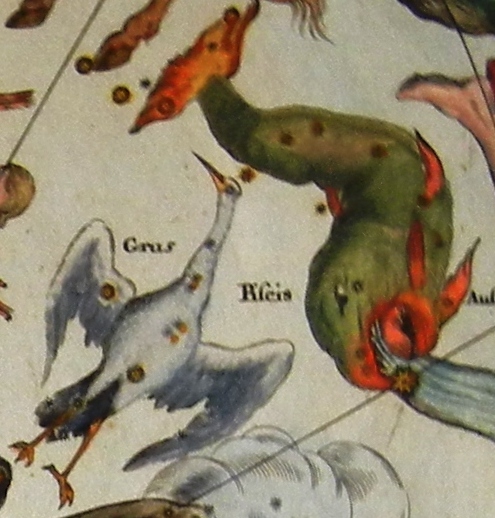|
Grus (constellation)
Grus (, or colloquially ) is a constellation in the southern sky. Its name is Latin for the crane (bird), crane, a type of bird. It is one of twelve constellations conceived by Petrus Plancius from the observations of Pieter Dirkszoon Keyser and Frederick de Houtman. Grus first appeared on a celestial globe published in 1598 in Amsterdam by Plancius and Jodocus Hondius and was depicted in Johann Bayer's star atlas ''Uranometria'' of 1603. French explorer and astronomer Nicolas-Louis de Lacaille gave Bayer designations to its stars in 1756, some of which had been previously considered part of the neighbouring constellation Piscis Austrinus. The constellations Grus, Pavo (constellation), Pavo, Phoenix (constellation), Phoenix and Tucana are collectively known as the "Southern Birds". The constellation's brightest star, Alpha Gruis, is also known as Alnair and appears as a 1.7-Apparent magnitude, magnitude blue-white star. Beta Gruis is a red giant variable star with a minimum mag ... [...More Info...] [...Related Items...] OR: [Wikipedia] [Google] [Baidu] |
Crane (bird)
Cranes are a type of large bird with long legs and necks in the Family (biology), biological family Gruidae of the Order (biology), order Gruiformes. The family has 15 species placed in four genera which are ''Antigone (genus), Antigone'', ''Balearica'', ''Siberian crane, Leucogeranus'', and ''Grus (genus), Grus''. They are large birds with long necks and legs, a tapering form, and long secondary feathers on the wing that project over the tail. Most species have muted gray or white plumages, marked with black, and red bare patches on the face, but the crowned cranes of the genus ''Balearica'' have vibrantly-coloured wings and golden "crowns" of feathers. Cranes fly with their necks extended outwards instead of bent into an S-shape and their long legs outstretched. Cranes live on most continents, with the exception of Antarctica and South America. Some species and populations of cranes bird migration, migrate over long distances; others do not migrate at all. Cranes are solitary du ... [...More Info...] [...Related Items...] OR: [Wikipedia] [Google] [Baidu] |
Pieter Dirkszoon Keyser
Pieter Dirkszoon Keyser (occasionally Petrus Theodorus; – 11 September 1596) was a Dutch navigator and celestial cartographer who mapped several constellations on the southern celestial hemisphere. Voyages and star observation Little is known of Keyser's life outside of his astronomical observations and East Indies voyages. After making several voyages under the Portuguese flag, including one to Brazil, Keyser participated as the chief navigator and head of the steersmen for the first Dutch voyage to the East Indies (the "Eerste Schipvaart"), which left Texel with four ships on 2 April 1595 under Cornelis de Houtman. He had been trained by cartographer Petrus Plancius in mathematics and astronomy. Plancius, a key promoter to the Dutch East Indies expeditions, had instructed Keyser to map the skies in the Southern Celestial Hemisphere, southern hemisphere, which were largely uncharted at the time. When the fleet finally was able to obtain fresh supplies at Madagascar on 1 ... [...More Info...] [...Related Items...] OR: [Wikipedia] [Google] [Baidu] |
WASP-95
WASP-95 is a star away in the constellation Grus (constellation), Grus. With an apparent magnitude of 10.1, it is not visible to the naked eye. Its spectral type of G2 means it is a yellow sunlike star. Planetary system In 2013, a planet was discovered around WASP-95. The planet, WASP-95b, is a hot Jupiter about 10% more massive than Jupiter, and completes an orbit round its star every two days. It was discovered by its transit of the star in 2013. The planet's equilibrium temperature is 1692.6 Kelvin, K. References Grus (constellation) G-type main-sequence stars Planetary systems with one confirmed planet Durchmusterung objects, CD-48 14223 TESS Objects of Interest, 105 TIC objects, 144065872 Wide Angle Search for Planets, 95 {{main-star-stub ... [...More Info...] [...Related Items...] OR: [Wikipedia] [Google] [Baidu] |

